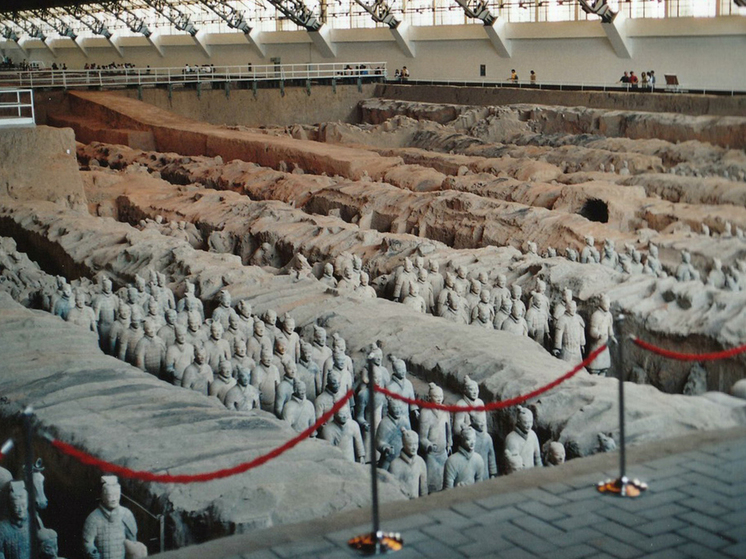The resting place of the first emperor of the Celestial Empire is shrouded in myths and rumors
While Netflix users are intrigued by a new documentary about a cursed 2,200-year-old tomb in China that experts are afraid to open, archaeologists have long been worried about the dangers of opening the still sealed tomb of the first Chinese emperor.

Rivers of poisonous liquid mercury, built to resemble a miniature map of the emperor's kingdom, are just one of many potential risks associated with the discovery of this most hidden site — the tomb of Emperor Qin Shi Huang, writes the Daily Mail.
Experts are also concerned that that the army of clay «terracotta warriors» sealed in the tomb may be on public display because the paint has instantly peeled and evaporated from similar sculptures buried next to the emperor's tomb, which is more than 2,200 years old.
Researchers have even turned to an exotic X-ray-like scanning technique called muon tomography, which uses cosmic rays from space to peer into the sealed burial site.
But naturally, there are also rumors of a curse on the tomb. and, of course, the seven locals who unearthed the first of Qin Shi Huang's nearly 8,000 buried clay warriors in 1974 paid a heavy price for their discovery.
«Secrets of the Terracotta Warriors» has reportedly been viewed 6.8 million times, rising to No. 4 on the streamer's «Most Viewed» list this week since the hour-and-17-minute documentary debuted on Netflix June 12 , notes the Daily Mail.
British director James Towell's «Stunning Documentary» explores the life, death and archaeological legacy of China's first emperor, Qin Shi Huang (259-210 BC), who managed to conquer and unite all of China in 221 BC.
Qin Shi Huang created an empire that lasted for about two millennia. His other achievements included beginning construction of the Great Wall of China, creating a nationwide road network, and standardizing writing and units of measurement.
But the discovery of Emperor Qin Shi Huang's terracotta soldiers, sculpted to serve his army in the afterlife, was less successful for the seven people who discovered the first known terracotta warriors of the Qin dynasty, the Daily Mail notes. These residents of a farming community near the city of Xi'an found a clay warrior's head while digging a new well during the devastating drought of 1974. From the moment this pottery-like clay head and several bronze arrowheads found with it were first revealed, widespread outrage ensued. The village's farmland was soon confiscated by the government due to its archaeological and historical value.
Over time, the houses were demolished to make way for museum exhibits and tourist shops. Three of these seven peasants died under tragic circumstances. Then, in 1997, 60-year-old Wang Puzhi committed suicide after facing insurmountable medical bills to treat his illnesses.
Two more peasants, Yang Wenhai and Yang Yanxin, died in their 50s years, also penniless and unable to pay for medical care on their own.
Others earned less than a few dollars a day for years by signing books for tourists at the official souvenir shops of the Mausoleum of the First Qin Emperor.
One of the surviving peasants, Yang Zhifa, was so outraged by his treatment that he did not go to see the restored army of sculptures until 1995, he told China Daily.
Although the discovery of the tomb remains one of the greatest archaeological discoveries of the 20th century, attempts to penetrate deeper into the tomb have encountered serious obstacles, writes the Daily Mail.
An analysis of the soil around the site revealed mercury levels 100 times higher than normal, which confirms the myth that the rivers and lakes of the Qin Dynasty, abundant in this substance, were created specifically for his tomb as part of a giant map of China.
«Every time we discover something, we conduct a thorough assessment risks,» Ming Tak Ted Hui, associate professor of classical and medieval Chinese at the University of Oxford, told DailyMail.com earlier in June this year.
«But if we look at the trend, I can say that it looks like we actually have more opportunity to do this,» says the researcher, who is featured in the new Netflix document.
He added that, Although improved technology is making it easier for researchers to carry out careful excavations, the Xi'an tombs, which may contain one of the emperor's heirs, Prince Gao, may face an additional problem — traps.
The existence of these traps was described in the work of the ancient historian Sima Qian, who wrote around 85 BC.
According to Sima Qian (145-86 BC), the official historian of the Han Dynasty , the imperial necropolis complex consisted of “palaces and picturesque towers for hundreds of officials,” which were carefully guarded.
The Qin underground tomb itself “was filled with rare artifacts and amazing treasures,” wrote this Han historian, and, to to preserve these treasures, «craftsmen were ordered to make crossbows and arrows ready to shoot anyone who entered the tomb.»
Associate Professor Ming Tak Ted Hui from the University of Oxford expressed confidence that archaeologists will one day uncover the tomb's deepest secrets , and he is glad to see that interest in it is growing.
«At a time when we seriously doubt the truth,» the «heroes» of the story, he says, are the people who gave their lives in present to better understand the past. In it you will find common interests or common secrets,” he said.






















































Свежие комментарии